University Report: Biological Markers and Patient Diagnosis Analysis
VerifiedAdded on 2023/04/21
|6
|1288
|181
Report
AI Summary
This problem-based report analyzes the use of biological markers in diagnosing a patient exhibiting symptoms such as fatigue, weakness, and changes in bowel movements. The report focuses on interpreting hematocrit and glucose levels from blood samples to identify potential conditions, including Addison's disease. It explores the relationship between these markers and patient symptoms, discussing the need for further diagnostic tests like hormone therapy and flow cytometry. The report emphasizes the importance of accurate diagnosis, ethical considerations, and the limitations of relying solely on initial blood test results. The student concludes that a comprehensive approach, combining clinical knowledge with advanced testing, is essential for effective patient care.
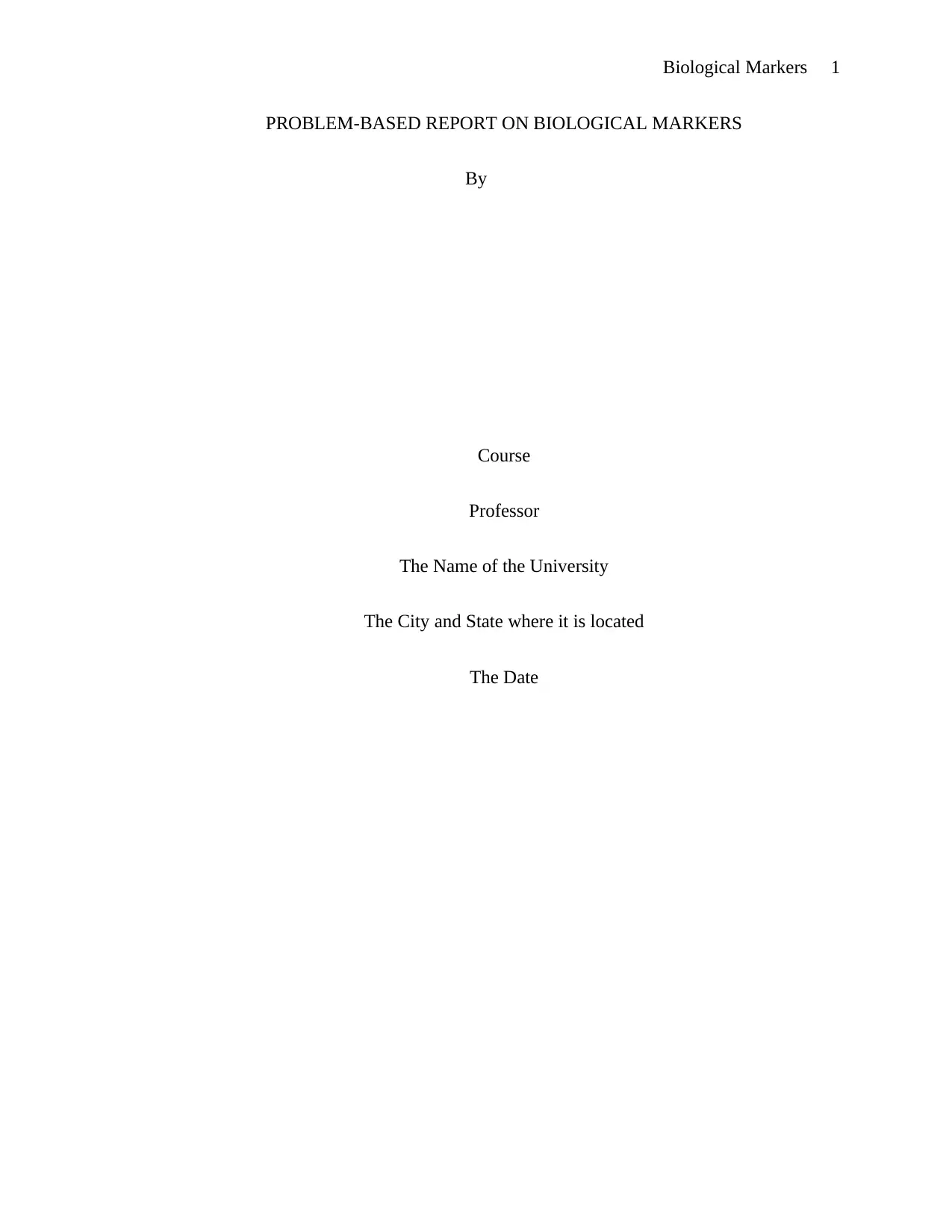
Biological Markers 1
PROBLEM-BASED REPORT ON BIOLOGICAL MARKERS
By
Course
Professor
The Name of the University
The City and State where it is located
The Date
PROBLEM-BASED REPORT ON BIOLOGICAL MARKERS
By
Course
Professor
The Name of the University
The City and State where it is located
The Date
Paraphrase This Document
Need a fresh take? Get an instant paraphrase of this document with our AI Paraphraser
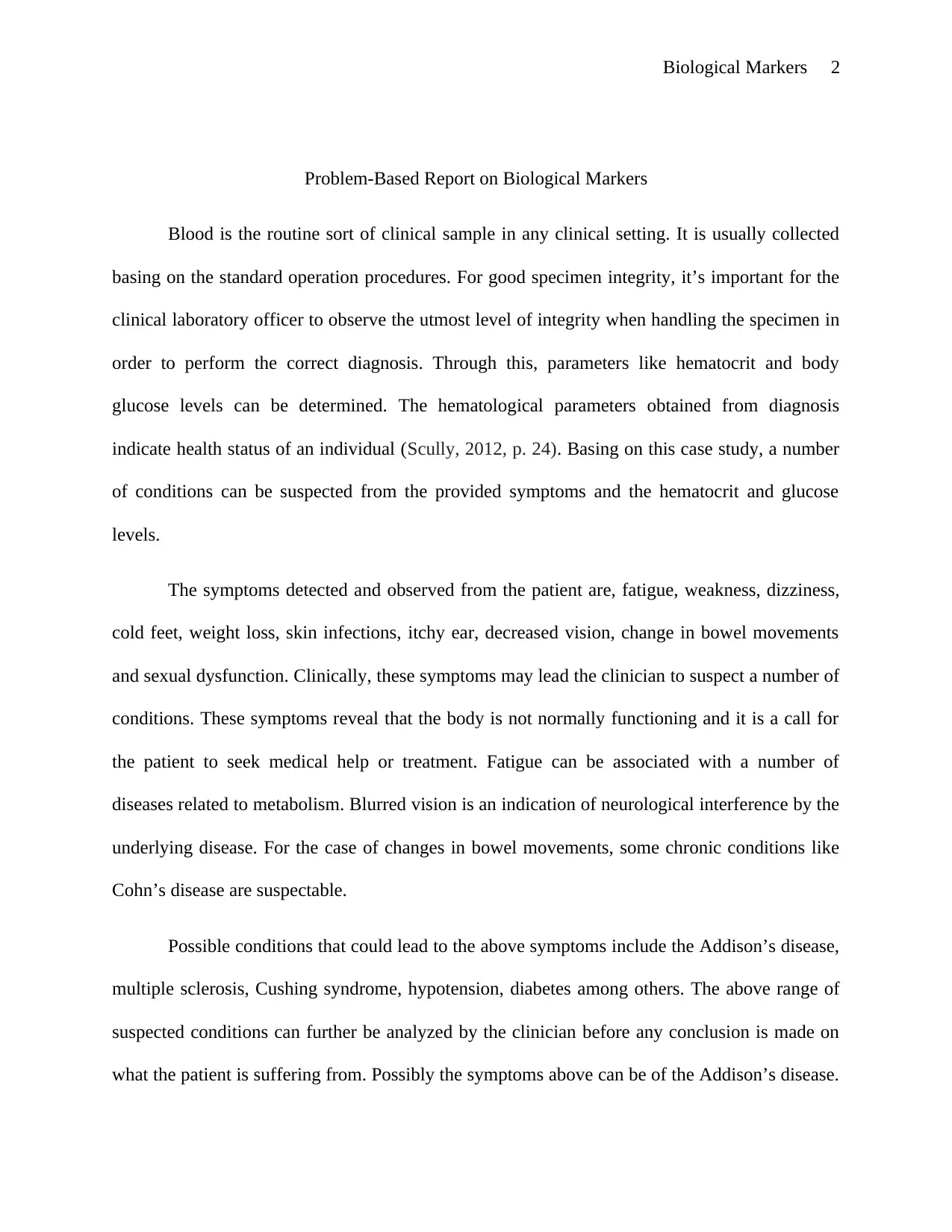
Biological Markers 2
Problem-Based Report on Biological Markers
Blood is the routine sort of clinical sample in any clinical setting. It is usually collected
basing on the standard operation procedures. For good specimen integrity, it’s important for the
clinical laboratory officer to observe the utmost level of integrity when handling the specimen in
order to perform the correct diagnosis. Through this, parameters like hematocrit and body
glucose levels can be determined. The hematological parameters obtained from diagnosis
indicate health status of an individual (Scully, 2012, p. 24). Basing on this case study, a number
of conditions can be suspected from the provided symptoms and the hematocrit and glucose
levels.
The symptoms detected and observed from the patient are, fatigue, weakness, dizziness,
cold feet, weight loss, skin infections, itchy ear, decreased vision, change in bowel movements
and sexual dysfunction. Clinically, these symptoms may lead the clinician to suspect a number of
conditions. These symptoms reveal that the body is not normally functioning and it is a call for
the patient to seek medical help or treatment. Fatigue can be associated with a number of
diseases related to metabolism. Blurred vision is an indication of neurological interference by the
underlying disease. For the case of changes in bowel movements, some chronic conditions like
Cohn’s disease are suspectable.
Possible conditions that could lead to the above symptoms include the Addison’s disease,
multiple sclerosis, Cushing syndrome, hypotension, diabetes among others. The above range of
suspected conditions can further be analyzed by the clinician before any conclusion is made on
what the patient is suffering from. Possibly the symptoms above can be of the Addison’s disease.
Problem-Based Report on Biological Markers
Blood is the routine sort of clinical sample in any clinical setting. It is usually collected
basing on the standard operation procedures. For good specimen integrity, it’s important for the
clinical laboratory officer to observe the utmost level of integrity when handling the specimen in
order to perform the correct diagnosis. Through this, parameters like hematocrit and body
glucose levels can be determined. The hematological parameters obtained from diagnosis
indicate health status of an individual (Scully, 2012, p. 24). Basing on this case study, a number
of conditions can be suspected from the provided symptoms and the hematocrit and glucose
levels.
The symptoms detected and observed from the patient are, fatigue, weakness, dizziness,
cold feet, weight loss, skin infections, itchy ear, decreased vision, change in bowel movements
and sexual dysfunction. Clinically, these symptoms may lead the clinician to suspect a number of
conditions. These symptoms reveal that the body is not normally functioning and it is a call for
the patient to seek medical help or treatment. Fatigue can be associated with a number of
diseases related to metabolism. Blurred vision is an indication of neurological interference by the
underlying disease. For the case of changes in bowel movements, some chronic conditions like
Cohn’s disease are suspectable.
Possible conditions that could lead to the above symptoms include the Addison’s disease,
multiple sclerosis, Cushing syndrome, hypotension, diabetes among others. The above range of
suspected conditions can further be analyzed by the clinician before any conclusion is made on
what the patient is suffering from. Possibly the symptoms above can be of the Addison’s disease.
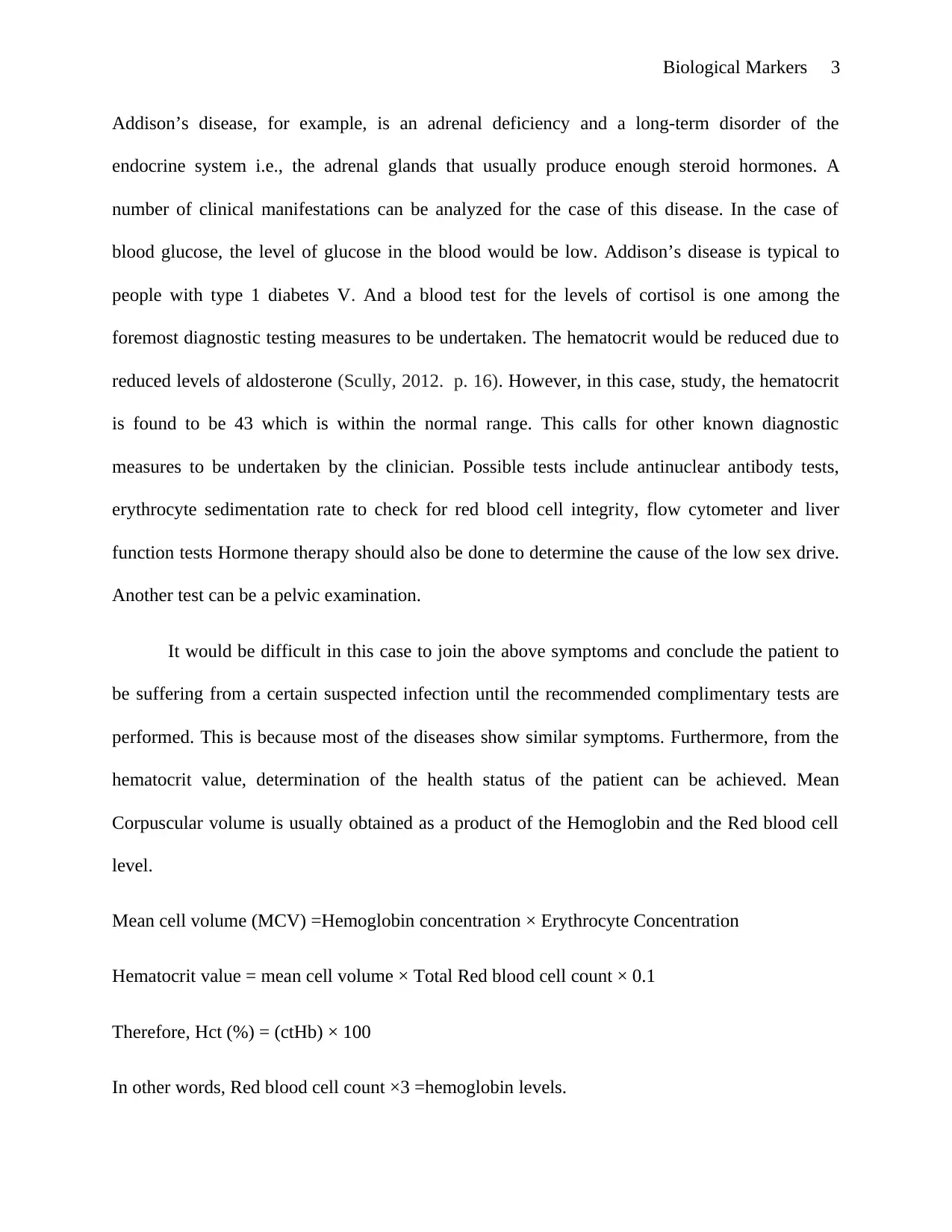
Biological Markers 3
Addison’s disease, for example, is an adrenal deficiency and a long-term disorder of the
endocrine system i.e., the adrenal glands that usually produce enough steroid hormones. A
number of clinical manifestations can be analyzed for the case of this disease. In the case of
blood glucose, the level of glucose in the blood would be low. Addison’s disease is typical to
people with type 1 diabetes V. And a blood test for the levels of cortisol is one among the
foremost diagnostic testing measures to be undertaken. The hematocrit would be reduced due to
reduced levels of aldosterone (Scully, 2012. p. 16). However, in this case, study, the hematocrit
is found to be 43 which is within the normal range. This calls for other known diagnostic
measures to be undertaken by the clinician. Possible tests include antinuclear antibody tests,
erythrocyte sedimentation rate to check for red blood cell integrity, flow cytometer and liver
function tests Hormone therapy should also be done to determine the cause of the low sex drive.
Another test can be a pelvic examination.
It would be difficult in this case to join the above symptoms and conclude the patient to
be suffering from a certain suspected infection until the recommended complimentary tests are
performed. This is because most of the diseases show similar symptoms. Furthermore, from the
hematocrit value, determination of the health status of the patient can be achieved. Mean
Corpuscular volume is usually obtained as a product of the Hemoglobin and the Red blood cell
level.
Mean cell volume (MCV) =Hemoglobin concentration × Erythrocyte Concentration
Hematocrit value = mean cell volume × Total Red blood cell count × 0.1
Therefore, Hct (%) = (ctHb) × 100
In other words, Red blood cell count ×3 =hemoglobin levels.
Addison’s disease, for example, is an adrenal deficiency and a long-term disorder of the
endocrine system i.e., the adrenal glands that usually produce enough steroid hormones. A
number of clinical manifestations can be analyzed for the case of this disease. In the case of
blood glucose, the level of glucose in the blood would be low. Addison’s disease is typical to
people with type 1 diabetes V. And a blood test for the levels of cortisol is one among the
foremost diagnostic testing measures to be undertaken. The hematocrit would be reduced due to
reduced levels of aldosterone (Scully, 2012. p. 16). However, in this case, study, the hematocrit
is found to be 43 which is within the normal range. This calls for other known diagnostic
measures to be undertaken by the clinician. Possible tests include antinuclear antibody tests,
erythrocyte sedimentation rate to check for red blood cell integrity, flow cytometer and liver
function tests Hormone therapy should also be done to determine the cause of the low sex drive.
Another test can be a pelvic examination.
It would be difficult in this case to join the above symptoms and conclude the patient to
be suffering from a certain suspected infection until the recommended complimentary tests are
performed. This is because most of the diseases show similar symptoms. Furthermore, from the
hematocrit value, determination of the health status of the patient can be achieved. Mean
Corpuscular volume is usually obtained as a product of the Hemoglobin and the Red blood cell
level.
Mean cell volume (MCV) =Hemoglobin concentration × Erythrocyte Concentration
Hematocrit value = mean cell volume × Total Red blood cell count × 0.1
Therefore, Hct (%) = (ctHb) × 100
In other words, Red blood cell count ×3 =hemoglobin levels.
⊘ This is a preview!⊘
Do you want full access?
Subscribe today to unlock all pages.

Trusted by 1+ million students worldwide
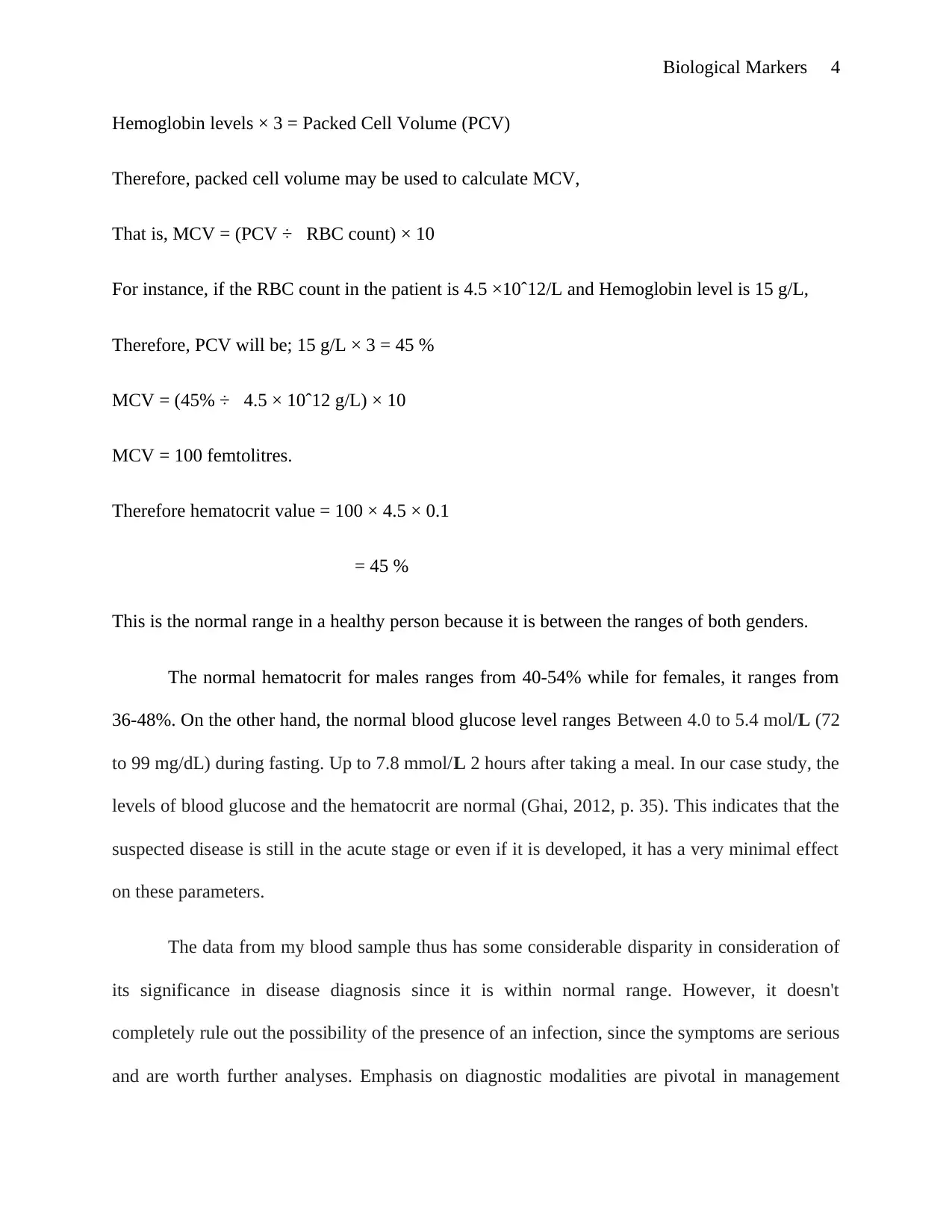
Biological Markers 4
Hemoglobin levels × 3 = Packed Cell Volume (PCV)
Therefore, packed cell volume may be used to calculate MCV,
That is, MCV = (PCV ÷ RBC count) × 10
For instance, if the RBC count in the patient is 4.5 ×10ˆ12/L and Hemoglobin level is 15 g/L,
Therefore, PCV will be; 15 g/L × 3 = 45 %
MCV = (45% ÷ 4.5 × 10ˆ12 g/L) × 10
MCV = 100 femtolitres.
Therefore hematocrit value = 100 × 4.5 × 0.1
= 45 %
This is the normal range in a healthy person because it is between the ranges of both genders.
The normal hematocrit for males ranges from 40-54% while for females, it ranges from
36-48%. On the other hand, the normal blood glucose level ranges Between 4.0 to 5.4 mol/L (72
to 99 mg/dL) during fasting. Up to 7.8 mmol/L 2 hours after taking a meal. In our case study, the
levels of blood glucose and the hematocrit are normal (Ghai, 2012, p. 35). This indicates that the
suspected disease is still in the acute stage or even if it is developed, it has a very minimal effect
on these parameters.
The data from my blood sample thus has some considerable disparity in consideration of
its significance in disease diagnosis since it is within normal range. However, it doesn't
completely rule out the possibility of the presence of an infection, since the symptoms are serious
and are worth further analyses. Emphasis on diagnostic modalities are pivotal in management
Hemoglobin levels × 3 = Packed Cell Volume (PCV)
Therefore, packed cell volume may be used to calculate MCV,
That is, MCV = (PCV ÷ RBC count) × 10
For instance, if the RBC count in the patient is 4.5 ×10ˆ12/L and Hemoglobin level is 15 g/L,
Therefore, PCV will be; 15 g/L × 3 = 45 %
MCV = (45% ÷ 4.5 × 10ˆ12 g/L) × 10
MCV = 100 femtolitres.
Therefore hematocrit value = 100 × 4.5 × 0.1
= 45 %
This is the normal range in a healthy person because it is between the ranges of both genders.
The normal hematocrit for males ranges from 40-54% while for females, it ranges from
36-48%. On the other hand, the normal blood glucose level ranges Between 4.0 to 5.4 mol/L (72
to 99 mg/dL) during fasting. Up to 7.8 mmol/L 2 hours after taking a meal. In our case study, the
levels of blood glucose and the hematocrit are normal (Ghai, 2012, p. 35). This indicates that the
suspected disease is still in the acute stage or even if it is developed, it has a very minimal effect
on these parameters.
The data from my blood sample thus has some considerable disparity in consideration of
its significance in disease diagnosis since it is within normal range. However, it doesn't
completely rule out the possibility of the presence of an infection, since the symptoms are serious
and are worth further analyses. Emphasis on diagnostic modalities are pivotal in management
Paraphrase This Document
Need a fresh take? Get an instant paraphrase of this document with our AI Paraphraser
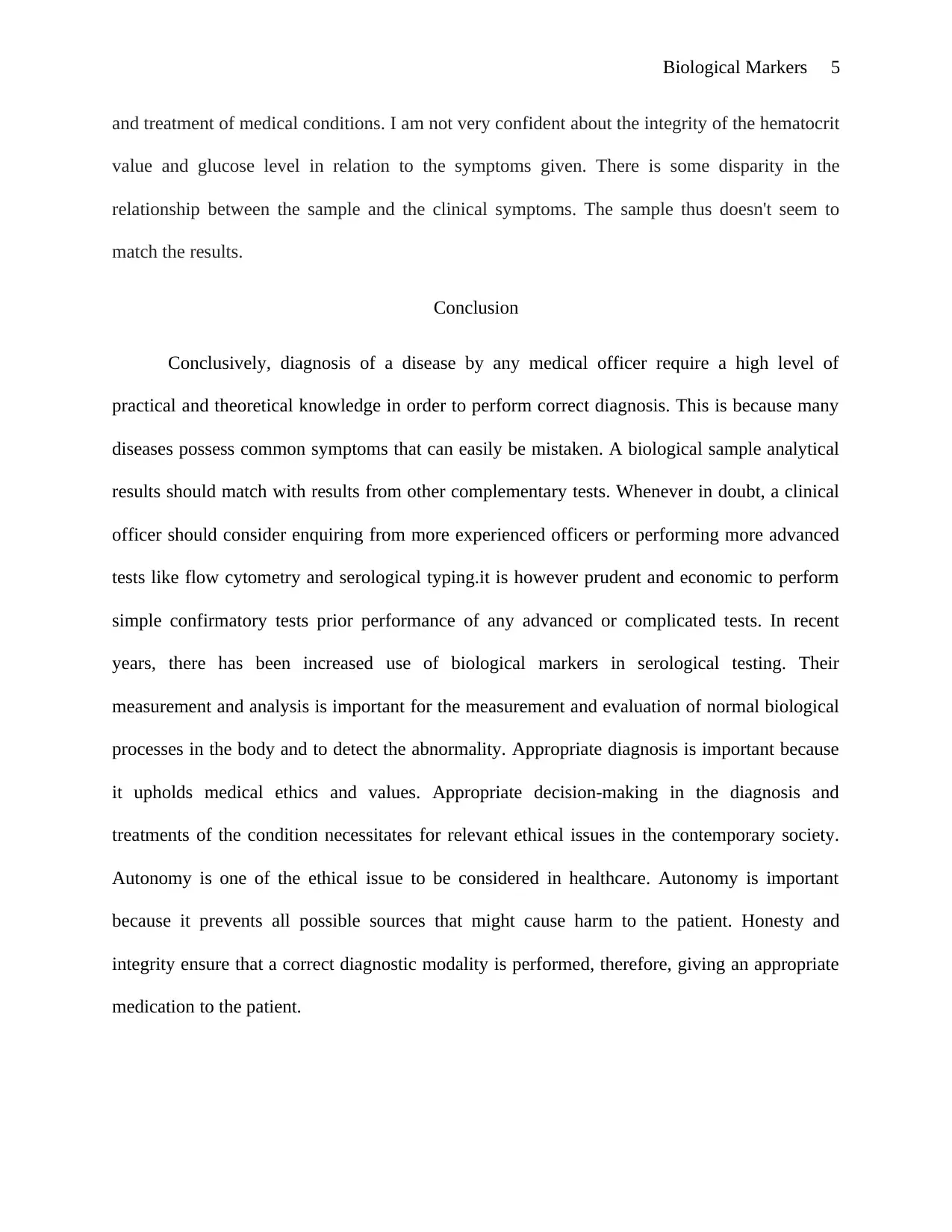
Biological Markers 5
and treatment of medical conditions. I am not very confident about the integrity of the hematocrit
value and glucose level in relation to the symptoms given. There is some disparity in the
relationship between the sample and the clinical symptoms. The sample thus doesn't seem to
match the results.
Conclusion
Conclusively, diagnosis of a disease by any medical officer require a high level of
practical and theoretical knowledge in order to perform correct diagnosis. This is because many
diseases possess common symptoms that can easily be mistaken. A biological sample analytical
results should match with results from other complementary tests. Whenever in doubt, a clinical
officer should consider enquiring from more experienced officers or performing more advanced
tests like flow cytometry and serological typing.it is however prudent and economic to perform
simple confirmatory tests prior performance of any advanced or complicated tests. In recent
years, there has been increased use of biological markers in serological testing. Their
measurement and analysis is important for the measurement and evaluation of normal biological
processes in the body and to detect the abnormality. Appropriate diagnosis is important because
it upholds medical ethics and values. Appropriate decision-making in the diagnosis and
treatments of the condition necessitates for relevant ethical issues in the contemporary society.
Autonomy is one of the ethical issue to be considered in healthcare. Autonomy is important
because it prevents all possible sources that might cause harm to the patient. Honesty and
integrity ensure that a correct diagnostic modality is performed, therefore, giving an appropriate
medication to the patient.
and treatment of medical conditions. I am not very confident about the integrity of the hematocrit
value and glucose level in relation to the symptoms given. There is some disparity in the
relationship between the sample and the clinical symptoms. The sample thus doesn't seem to
match the results.
Conclusion
Conclusively, diagnosis of a disease by any medical officer require a high level of
practical and theoretical knowledge in order to perform correct diagnosis. This is because many
diseases possess common symptoms that can easily be mistaken. A biological sample analytical
results should match with results from other complementary tests. Whenever in doubt, a clinical
officer should consider enquiring from more experienced officers or performing more advanced
tests like flow cytometry and serological typing.it is however prudent and economic to perform
simple confirmatory tests prior performance of any advanced or complicated tests. In recent
years, there has been increased use of biological markers in serological testing. Their
measurement and analysis is important for the measurement and evaluation of normal biological
processes in the body and to detect the abnormality. Appropriate diagnosis is important because
it upholds medical ethics and values. Appropriate decision-making in the diagnosis and
treatments of the condition necessitates for relevant ethical issues in the contemporary society.
Autonomy is one of the ethical issue to be considered in healthcare. Autonomy is important
because it prevents all possible sources that might cause harm to the patient. Honesty and
integrity ensure that a correct diagnostic modality is performed, therefore, giving an appropriate
medication to the patient.

Biological Markers 6
References
Ghai, C.L., 2012. A textbook of practical physiology. JP Medical Ltd.
Scully, C., 2012. Oral and Maxillofacial Medicine-E-Book: The Basis of Diagnosis and
Treatment. Elsevier Health Sciences.
References
Ghai, C.L., 2012. A textbook of practical physiology. JP Medical Ltd.
Scully, C., 2012. Oral and Maxillofacial Medicine-E-Book: The Basis of Diagnosis and
Treatment. Elsevier Health Sciences.
⊘ This is a preview!⊘
Do you want full access?
Subscribe today to unlock all pages.

Trusted by 1+ million students worldwide
1 out of 6
Related Documents
Your All-in-One AI-Powered Toolkit for Academic Success.
+13062052269
info@desklib.com
Available 24*7 on WhatsApp / Email
![[object Object]](/_next/static/media/star-bottom.7253800d.svg)
Unlock your academic potential
Copyright © 2020–2025 A2Z Services. All Rights Reserved. Developed and managed by ZUCOL.





